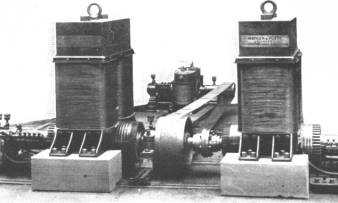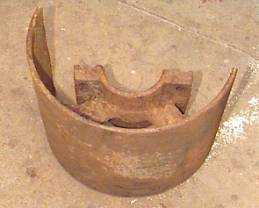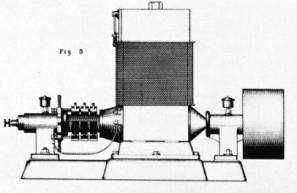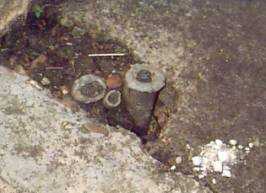|
ARCHAEOLOGY
MACHINERY
The buildings are the most obvious physical
evidence of the generating station.
Yet, other features remain on and in the ground
as important clues to the type and capacity of
machinery. The
dimensions of the concrete mounts and the flywheel
trough indicate a medium size reciprocating steam
engine. A
broken pulley of approximately 12” diameter, unearthed
on site is similar in
design to
those used on
Edison-Hopkinson dynamos.

Two
Edison-Hopkinson machines showing pulley
The Edison-Hopkinson dynamo was very popular and can be
seen operating in the photograph of the ‘Stockwell’
generating station.
The steam engine was however, probably more of
the size of that pictured at the Manchester Electric
Lighting Works.

Cast
iron dynamo pulley - 12" dia.
Cable
ends on site appear to be of the lead sheathed, copper
cored variety. Underground
cables must run between Lime Park and Herstmonceux
village.

Drawing
of small Edison-Hopkinson dynamo
Inside
the building, wiring was secured inside wooden conduit.
This wiring had waxed
cotton, or similar insulation.
Unfortunately, it was all replaced in the
rewiring process. Only
a small sample of the wooden conduit remains.

Subsoil
cable ends
Herstmonceux
Electricity Generating Works Circa. 1900 -
1936
Introduction
| Instructions
| ISBN
| Batteries
| Boiler
Room | Floor
Plan | Ron
Saunders
Industrial
Revolution
| Lime
Park | Machinery
| Map
| Power
House | Argus
1999
Public
Supply
| Roof
Construction | Rural
Supply | Sussex
Express 1913 |
Conclusion
Archaeology
South East
| East
Sussex CC | English
Heritage | SIAS
| Sx
Exp 1999
Memories
of Herstmonceux by Margaret Pollard
|